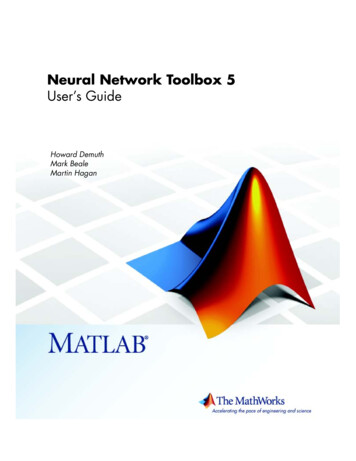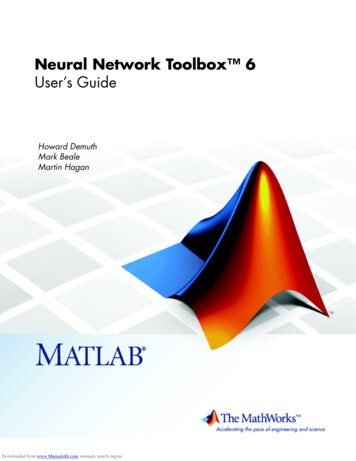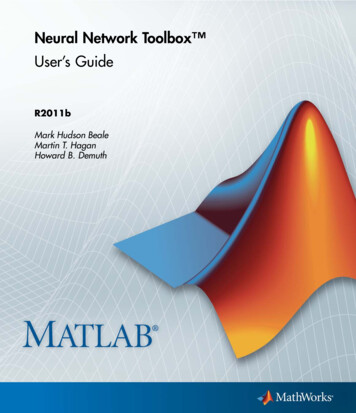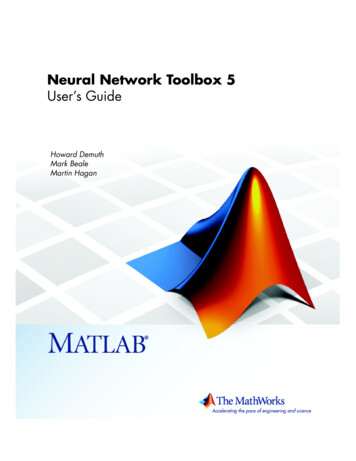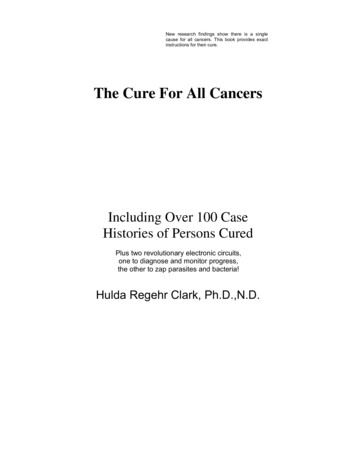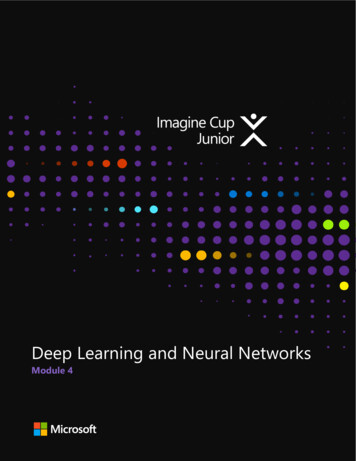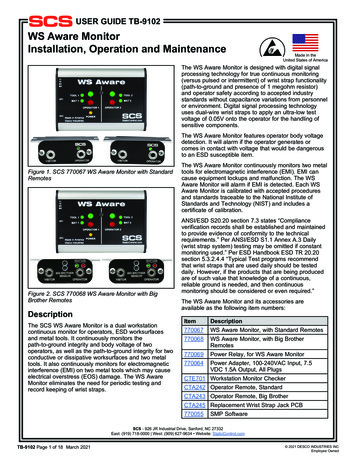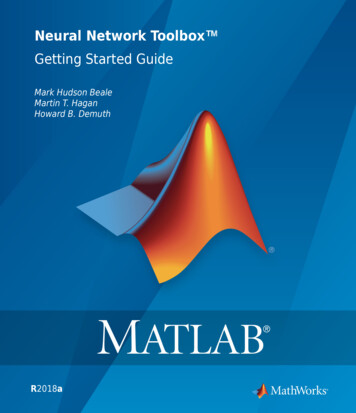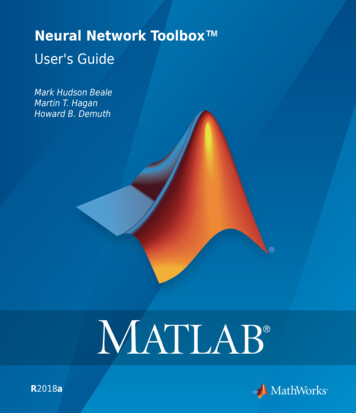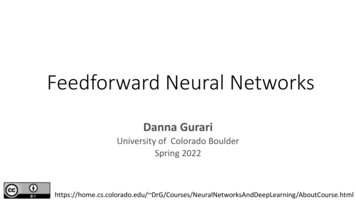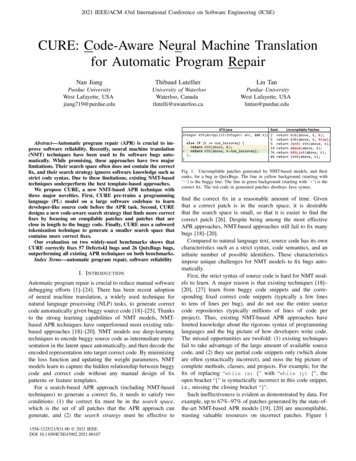
Transcription
2021 IEEE/ACM 43rd International Conference on Software Engineering (ICSE)CURE: Code-Aware Neural Machine Translationfor Automatic Program RepairNan JiangThibaud LutellierLin TanPurdue UniversityWest Lafayette, USAjiang719@purdue.eduUniversity of WaterlooWaterloo, Canadatlutelli@uwaterloo.caPurdue UniversityWest Lafayette, USAlintan@purdue.eduAbstract—Automatic program repair (APR) is crucial to improve software reliability. Recently, neural machine translation(NMT) techniques have been used to fix software bugs automatically. While promising, these approaches have two majorlimitations. Their search space often does not contain the correctfix, and their search strategy ignores software knowledge such asstrict code syntax. Due to these limitations, existing NMT-basedtechniques underperform the best template-based approaches.We propose CURE, a new NMT-based APR technique withthree major novelties. First, CURE pre-trains a programminglanguage (PL) model on a large software codebase to learndeveloper-like source code before the APR task. Second, CUREdesigns a new code-aware search strategy that finds more correctfixes by focusing on compilable patches and patches that areclose in length to the buggy code. Finally, CURE uses a subwordtokenization technique to generate a smaller search space thatcontains more correct fixes.Our evaluation on two widely-used benchmarks shows thatCURE correctly fixes 57 Defects4J bugs and 26 QuixBugs bugs,outperforming all existing APR techniques on both benchmarks.Index Terms—automatic program repair, software reliabilityI. I NTRODUCTIONAutomatic program repair is crucial to reduce manual softwaredebugging efforts [1]–[24]. There has been recent adoptionof neural machine translation, a widely used technique fornatural language processing (NLP) tasks, to generate correctcode automatically given buggy source code [18]–[25]. Thanksto the strong learning capabilities of NMT models, NMTbased APR techniques have outperformed most existing rulebased approaches [18]–[20]. NMT models use deep-learningtechniques to encode buggy source code as intermediate representation in the latent space automatically, and then decode theencoded representation into target correct code. By minimizingthe loss function and updating the weight parameters, NMTmodels learn to capture the hidden relationship between buggycode and correct code without any manual design of fixpatterns or feature templates.For a search-based APR approach (including NMT-basedtechniques) to generate a correct fix, it needs to satisfy twoconditions: (1) the correct fix must be in the search space,which is the set of all patches that the APR approach cangenerate, and (2) the search strategy must be effective to1558-1225/21/ 31.00 2021 IEEE.DOI 10.1109/ICSE43902.2021.00107Fig. 1. Uncompilable patches generated by NMT-based models, and theirranks, for a bug in QuixBugs. The line in yellow background (starting with‘-’) is the buggy line. The line in green background (starting with ‘ ’) is thecorrect fix. The red code in generated patches disobeys Java syntax.find the correct fix in a reasonable amount of time. Giventhat a correct patch is in the search space, it is desirablethat the search space is small, so that it is easier to find thecorrect patch [26]. Despite being among the most effectiveAPR approaches, NMT-based approaches still fail to fix manybugs [18]–[20].Compared to natural language text, source code has its owncharacteristics such as a strict syntax, code semantics, and aninfinite number of possible identifiers. These characteristicsimpose unique challenges for NMT models to fix bugs automatically.First, the strict syntax of source code is hard for NMT models to learn. A major reason is that existing techniques [18]–[20], [27] learn from buggy code snippets and the corresponding fixed correct code snippets (typically a few linesto tens of lines per bug), and do not use the entire sourcecode repositories (typically millions of lines of code perproject). Thus, existing NMT-based APR approaches havelimited knowledge about the rigorous syntax of programminglanguages and the big picture of how developers write code.The missed opportunities are twofold: (1) existing techniquesfail to take advantage of the large amount of available sourcecode, and (2) they see partial code snippets only (which aloneare often syntactically incorrect), and miss the big picture ofcomplete methods, classes, and projects. For example, for thefix of replacing “while (x) {” with “while (y) {”, theopen bracket “{” is syntactically incorrect in this code snippet,i.e., missing the closing bracket “}”.Such ineffectiveness is evident as demonstrated by data. Forexample, up to 67%–97% of patches generated by the state-ofthe-art NMT-based APR models [19], [20] are uncompilable,wasting valuable resources on incorrect patches. Figure 1
shows a bug in QuixBugs and some of the top-ranked patchesgenerated by CoCoNuT [19]. All of these patches are uncompilable, because they call methods with wrong parameters,invoke undeclared variables, or contain mismatched parenthesis. One important reason that CoCoNuT fails to generate acorrect patch for this bug despite generating 20,000 patches,is the large number of uncompilable patches. The code-awareNMT-based approach we propose automatically generates acorrect patch (identical to the line highlighted in green)for this bug. The ranks of these uncompilable patches arehigh because existing NMT-based APR techniques focus ontranslating buggy code snippets to correct code snippets, whichare partial code segments instead of full methods or programs.Since they fail to see the whole picture of the entire programor programming languages, they generate many patches withsyntax errors.Failing to learn how developers write code, existingNMT-based APR techniques also generate compilable butobviously-incorrect patches, as they do not look likedeveloper-written code. These uncompilable and compilablebut-incorrect patches decrease the accuracy and efficiency ofAPR models, preventing APR models from generating morecorrect patches faster.Second, the infinite number of possible identifiers causesNMT techniques for code to handle an enormous vocabulary ifusing word-level tokenization, where a vocabulary contains allthe unique tokens that an NMT model recognizes. Consideringthe complexity of NMT architectures, it is computationally tooexpensive for NMT-based APR models to use an enormousvocabulary. Yet with a limited vocabulary size, their searchspaces do not contain all correct fixes. SequenceR [20] usesa small vocabulary and shirks this complexity to a laterreconstruction stage, while CoCoNuT [19] uses a vocabularyof more than 130,000 tokens but still suffers from the outof-vocabulary (OOV, i.e., an NMT model cannot recognize orgenerate a token) problem, resulting in its search space thatstill misses correct fixes.A. Our approachThus, we propose an NMT-based approach that is speciallydesigned to parse, analyze, model, and search source code (asopposed to natural language text) to fix bugs automatically.Our approach, CURE, not only improves the search space (asmaller search space containing more correct patches) but alsouses a more effective search strategy to find and rank correctpatches higher, which are achieved through the following threemain techniques that we design and use:(1) Programming language models: To help NMT modelslearn developer-like source code (i.e., not only compilablebut also similar to those written by programmers), we applythe pre-training and fine-tuning workflow to the APR task.Specifically, pre-trained language models have brought greatimprovement to many NLP tasks [28], [29]. They learn theprobability distribution over sequences of words from a largeamount of natural language text. Then one fine-tunes the pretrained language model for a specific task by adding an extramodel to it (e.g., adding a classifier for classification tasks).The language model provides vectorized representations ofinput sequences to the model added to it. Since a pre-trainedlanguage model is typically trained on a larger dataset (since itis unsupervised learning and does not require ground truth), itoffers the added model more information regarding sentencestructures (e.g., syntax) and about what human-like text are(e.g., readability), which improves the quality of the generatedtext of the fine-tuned model for the specific task significantly.Given the effectiveness of language models in the NLPdomain, we propose to add a language model pre-trainedon software code, referred to as programming language (PL)model, to an NMT architecture to create a new APR architecture. The PL model is trained to predict the next tokensin code sequences and learns to generate developer-like code.Then, we combine the PL model and the NMT model to formthe full APR model and fine-tune it for APR tasks.Our PL-enhanced NMT approach ranks correct patcheshigher in the search space to fix more bugs (Section V-B1).(2) Code-aware search strategy: When using an NMT modelto generate a sequence of tokens to form a patch, ideally,one prefers the sequence with the highest score, e.g., averagelog probability of every token in sequence. Since this isprohibitively expensive [30], in practice, one uses a searchstrategy to choose proper tokens at each step. Beam searchis a common search strategy for NMT that keeps the most nprobable sequences at each step, where n is the beam size.The beam size of NLP tasks is typically 5 to 20 [30],[31]. Since source code has more possible identifiers and abigger search space than natural languages [19], [20], the NMTmodels for APR usually require larger beam sizes (100 [20] to1,000 [19]) to generate enough candidate patches. However,with large beam sizes, the vanilla beam search chooses manybad patches, either uncompilable or far from correct in length.To address this challenge, we propose two solutions: valididentifier-check strategy and length-control strategy. First,since source code is a formal language, only valid tokensare allowed, including keywords and variables in scope. Invalid tokens make a patched program uncompilable, let alonecapable of passing test cases. Therefore, we propose anddesign a valid-identifier-check strategy to improve the vanillabeam search, which performs static analysis to identify allvalid identifiers and then forces beam search to generate onlysequences with valid tokens.Second, with a large beam size, beam search finds manyvery short sequences such as “{” and “try {”, which areincorrect code snippets to fix bugs. Since correct fixes in ourtraining data are typically of similar length to the buggy lines,we use a length-control strategy to punish too-short and toolong sequences to prompt CURE to generate patches of asimilar length to the buggy line.Our code-aware beam-search strategy finds more correctfixes by generating more compilable patches and patches ofsimilar length to the buggy lines. (Section V-B2).(3) Subword tokenization: The enhanced word-level tok-
enization proposed by CoCoNuT [19] reduces the vocabularysize of code, by using camel letters, underscores, and numbersto split long identifiers. However, many compound words(such as “binsearch” for binary search) do not containthese special characters. The previous parsing approach keeps“binsearch” as one word, which is OOV, instead of breaking it into “bin” and “search”, both of which are in thevocabulary. Thus, we use byte-pair encoding (BPE), a type ofsubword tokenization techniques, to tokenize compound wordsand rare words to further address the OOV problem.BPE improves the search space by both including morecorrect patches and reducing its size (Section V-B3).B. ContributionsWe design and implement a code-aware NMT-based technique,CURE, to fix bugs automatically. Our contributions include: An approach to pre-train a PL model for APR on a verylarge software codebase—4.04 million methods from1,700 open-source projects—to capture code syntax anddeveloper-like source code, A new APR architecture that combines a pre-trained PLmodel and NMT architectures to learn both code syntaxand fix patterns, A new code-aware beam-search strategy, which usesvalid-identifier-check and length-control strategies to findmore correct fixes, A new application of subword tokenization to the APRtask, which addresses the OOV problem effectively, and A new APR approach, CURE, that combines the techniques above, and its evaluation on two widely-usedbenchmarks—Defects4J and QuixBugs, where CUREfixes the most number of bugs, 57 and 26 bugs respectively, outperforming all existing APR tools. CURE is thefirst NMT-based approach that outperforms all state-ofthe-art APR approaches on Defects4J.Availability: Data is available in a GitHub repository1 .II. BACKGROUNDCandidate, Plausible and Correct Patches: Following previous work [19], we call patches generated by the modelscandidate patches. Patches that pass the validation stage areplausible, and patches identical or semantically equivalent todevelopers’ patches are called correct patches.Parameters and Hyperparameters: Parameters are theweights between the connections of the network. These parameters are optimized during the training phase. Hyperparametersare arguments of the network defined before the trainingprocess. They generally include layer dimensions, number oflayers, and optimization parameters.Pre-Training and Fine-Tuning: Pre-training is the process oftraining a model for a general task (e.g., next word prediction)with a very large dataset. After pre-training, one gets a pretrained model with updated parameters. A pre-trained model1 https://github.com/lin-tan/CUREcan be fine-tuned for a similar but specific task (e.g., textgeneration) with few training data. During fine-tuning, usuallyone needs to add extra models to the pre-trained model to fitthe task, and the parameters of both the pre-trained model andadded models are updated.Context-aware neural machine translation (CoNuT) architecture: We use CoNuT as our NMT architecture in this paper.CoNuT consists of a buggy lines encoder, a context encoder, amerger, a decoder, an attention module, and a token generationmodule, where the encoders and decoder are implementedwith convolutional sequence-to-sequence architecture [32].The details of CoNuT is described in [19]. CoNuT has showngood results for APR, and convolutional architecture can bestacked to capture hierarchical features and long dependenciesfor larger contexts [19].III. A PPROACHTo address the challenges described in the Introduction, wedesign and apply three novel techniques, i.e., subword tokenization to improve the search space (Section III-C), a programming language model to learn developer-like source codeand improve patch ranking (Section III-D and Section III-E),and a new code-aware beam-search strategy (Section III-G)to improve patch ranking and generate more correct patches.A. OverviewFigure 2 presents an overview of our approach. CURE consistsof three stages: training, inference, and validation. Duringthe training stage, CURE extracts methods from open-sourceprojects, referred to as PL training data, and tokenizes them(step 1a in Figure 2). Different from previous work [18]–[24], we use subword tokenization, which produces a smallerbut more accurate search space that contains more correctpatches. CURE uses these tokenized methods to train anew programming language model that learns developerlike source code with correct syntax (step 2 ). CURE alsotokenizes the buggy lines, context, and correct fixes extractedfrom the commit history of open-source projects, referred toas patch training data, into sequences of tokens (step 1b ). Weuse these sequences to fine-tune an ensemble of k APR models(step 3 ). Each APR model combines the PL model witha context-aware neural machine translation (CoNuT) model[19].During the inference stage, a user provides a buggy projectalong with the location of buggy lines to CURE. These arestandard input that existing APR tools require [1], [5], [19],[20], [33], [34]. CURE tokenizes the buggy and the contextlines (step 1c ), then analyzes the source code to extracta list of valid identifiers that are in scope of the buggylines (step 4 ). The patch generation module generates alist of candidate patches using a new code-aware beamsearch strategy (step 5 ). This new algorithm discards manyirrelevant patches on the fly (i.e., as soon as an invalid tokenis generated) and penalizes patches that are unlikely to becorrect (e.g., fixes that are very different from the buggy line
Fig. 2. Overview of CURE. Grey boxes represent major novelties of CURE. Circled numbers indicate the steps of generating patches with CURE.in length), which saves a lot of resources and allows CUREto search deeper for correct patches.In the validation stage, CURE validates candidate patchesby compiling and executing the test suites of the patchedprojects. CURE outputs a list of plausible patches (step 6 )for developers to examine.B. Data ExtractionCURE uses two different types of training data. First, theGPT PL model is trained on millions of methods extractedfrom open-source Java projects. Second, CURE fine-tunes thePL model for the APR task. This step requires APR specifictraining data (i.e., buggy lines, context, and correct fixes).We use CoCoNuT’s training data shared on GitHub [19].CoCoNuT’s authors extracted this dataset from open-sourcerepositories and identified buggy commits based on keywordsin commit messages (“fix,” “bug,” and “patch”). They alsocleaned the dataset using commit message anti-patterns (“rename,” “clean up,” “refactor,” “merge,” “misspelling,” and“compiler warning”). Similar to CoCoNuT, we use the methodsurrounding the buggy lines as context.C. Code Representation and TokenizationWord-level tokenization: To tokenize buggy-, context-, andfixed-lines to token sequences, CURE first uses enhancedword-level tokenization [19] to separate code lines by spaces,camel letters, underscores, strings, and numbers (except 0 and1).Out-of-vocabulary Issue: The vocabulary size after the wordlevel tokenization is larger than what is commonly usedin NLP and the test set still contains 2% of OOV tokens.Excluding rare tokens is problematic for source code becauseOOV tokens are likely to be important project-specific tokens.Excluding such tokens makes it difficult for NMT models tofix bugs in these new projects.Some existing NMT-based APR models [19] do not generate OOV tokens, missing the opportunity to fix more bugs.SequenceR uses a special token as a placeholder for OOVtokens, and then uses a copy mechanism to reconstruct them.(a) Buggy line and correct fix of Closure 62.(b) Word-level tokenization result of buggy line and correct fix.(c) Subword-level tokenization result of buggy line and correct fix.Fig. 3. Tokenized results that use word-level tokenization and subwordtokenization of Closure 62 in Defects4J.The copy mechanism replaces the placeholder tokens with themost likely token from the input buggy lines. However, thissolution would fail to generate some patches, since it can onlycopy tokens appearing in the buggy lines.Subword tokenization: To address the OOV problem andreduce the vocabulary size, we use byte pair encoding (BPE),which is an unsupervised learning algorithm to find the mostfrequent subwords in a corpus by merging the most frequentbyte pair iteratively [35]. BPE has been used in many NLPtasks and is useful to reduce vocabulary size and mitigate theOOV problem efficiently [35]–[37].Figure 3 shows an example from the inference stage demonstrating the effectiveness of the subword tokenization. Linesstarting with ‘-’ are the buggy lines (input) and those startingwith ‘ ’ are the correct fixes. Figure 3(a) shows the sourcecode of a real bug in Defects4J [38], while Figure 3(b) showsthe code after using the enhanced word-level tokenization.Figure 3(c) shows the same code tokenized by our subwordtokenization. In Figure 3, each consequence separated by spaceis a token excluding the ‘-’ and ‘ ’ signs.When using only the enhanced word-level tokenization,the variable “charno” is an OOV token. Thus, CoCoNuTand SequenceR fail to fix this bug since CoCoNuT cannotgenerate OOV tokens and SequenceR does not fix it correctlywith the copy mechanism. With our subword tokenization,
“charno” is split into two tokens, both of which appearin the vocabulary—“char@@” (“@@” indicates that the tokenneeds to be concatenated with the following token) and “no”,enabling CURE to generate a correct patch for this bug.By applying subword tokenization, we use a smaller vocabulary to form a smaller but better search space that containsmore correct patches. Section V-B3 evaluates the impact ofour subword tokenization approach.D. Programming Language ModelTo address the challenges of learning developer-like sourcecode, we train a language model on open-source programs,referred to as a programming language model (PL model). APL model optimizes the probability of a sequence of tokensbeing a real-world code snippet. We use Generative Pre-trainedTransformer (GPT) [37] for PL modeling because GPT hasbeen shown to improve the performance of many differentNLP tasks [37], [39].Pre-training a PL model allows for separating programminglanguage learning from patch learning. The advantages aretwofold. First, GPT learning is unsupervised and only requirescomplete methods; therefore one can extract a large amountof data automatically and accurately to train it. Second,during fine-tuning, the APR model already knows the PLsyntax (thanks to the PL model), making the fine-tuning moreefficient.Given a sequence of tokens representing a method, x (x1 , ., xn ), where xi is a token in the method sequence x, thePL modeling objective is to maximize the average likelihood:1 nΣ log P (xi x1 , ., xi 1 ; Θ)(1)n i 1where Θ represents matrices of trainable weights of the PLmodel. P (xi x1 , ., xi 1 ; Θ) is the conditional probability oftoken xi being the next token, given a sequence of x1 , ., xi 1 ,which is calculated by the PL model with weights Θ. At ahigh-level, the objective of the PL model training is to findthe best weights (Θ) so that sequences of tokens x1 , ., xnrepresenting real methods in projects obtain a higher LGP Tscore than other sequences. Since methods in popular opensource projects are dominantly well-formed correct blocksof code, we use them to train our PL model to learn if agiven sequence of tokens is likely to form real-world code(compilable and looks like written by programmers).LGP T (x) E. Fine-Tuning for APR with a PL ModelAfter pre-training the PL model, CURE fine-tunes the GPTPL model for the APR task by combining it with an NMTmodel as the APR model. We use the CoNuT (Section II) asCURE’s NMT architecture.The APR model takes buggy lines and their context as inputand aims to generate a correct patch. During the fine-tuningprocess, the APR model is trained to learn the transformationfrom the buggy lines and context (e.g., the buggy method)to the correct fix. We use xb (xb1 , ., xbn ) to denotethe buggy lines, x (x1 , .xcn ) to denote the context, andFig. 4. Architecture of the APR models used in CURE. Yellow, purple andgreen boxes refer to the buggy lines, context and the generated patch.y (y1 , ., yfn ) to denote the correct fixes, where b1 , ., bnare the indices of the buggy lines in the context, while cn andfn are the lengths of the context and correct fixes respectively.We denote the weights of the PL model as Θ and weightsof CoNuT as Φ. The APR model is fine-tuned by updating Θand Φ to maximize the following average log-likelihood:1 fnΣlog P (yi x, xb , y0 , . . ., yi 1 ; Θ, Φ)fn i 1y0 xb1 1(2)P (yi x, xb , y0 , . . . , yi 1 ; Θ, Φ) is the conditional probabilitycalculated by the APR model with weights Θ and Φ, whereyi is the token following the sequence (y0 , y1 , . . . , yi 1 ) in thecorrect fix, given the buggy lines xb and context x. For thefirst token in the correct fix, the probability is the conditionalprobability of token y1 given y0 , where y0 is the token rightbefore the correct fix, i.e., xb1 1 . For example, the entiremethod “kth()” is the context in Figure 1, while the buggylines and the correct fixes start at the same index in the context,and y0 is the token { right before the “return” statement.To prevent the PL model from losing the information itlearned during pre-training, we include the language modeling (i.e., LGP T ) as an auxiliary objective to the finetuning process. It also improves the generalization of the finetuned model [37]. Therefore, the APR model is fine-tuned bymaximizing the combined average log-likelihood:LN M T (x, xb , y) LAP R (x, xb , y) LN M T (x, xb , y) λLGP T (y0 )y0 (x1 , x2 , ., xb1 1 , y)(3)where y0 is the token sequence from the beginning ofthe buggy method to the last token in the correct fix(x1 , x2 , ., xb1 1 is the prefix of x before xb ). ProbabilityLGP T (y0 ) is the likelihood of y0 being a real source codesnippet, while λ is a hyperparameter referring to the coefficientof LGP T in the combined log-likelihood LAP R .
The fine-tuning stage aims to find the best set of parametersΘ and Φ to maximize LAP R for all buggy lines, context, andcorrect fixes in the training data.In the training mode, the APR model takes the pre-trainedGPT module (the PL model) and the patch training data asinput. The patch training data consists of the buggy lines, thecontext, and the correct fixes. We train the APR model formultiple epochs (i.e., multiple passes on the training data) toobtain the best combination of weights Θ and Φ.In the inference mode, the APR model has access to only thebuggy lines and their context and outputs a sequence of tokensrepresenting the patch. Figure 4 shows a simplified view of thearchitecture of our combined APR model and how the modelis used in inference mode. Our APR model consists of twocomponents: a PL model (GPT) and an NMT model (CoNuT).First, CURE generates the GPT representation of the contextlines (step 1 in Figure 4). As explained in Section III-D, theGPT model was trained on complete methods, therefore theinput of the GPT model needs to be a method. If we directlyfeed the first token of the buggy line to the GPT model (“int”in Figure 4), the GPT model will generate a bad embeddingfor it since it expects the first token of a sequence to be thefirst token of a method (e.g., “public”).Hence, the GPT model generates an embedding for alltokens in the buggy method. The CoNuT model contains twoencoders. The buggy lines encoder only takes the representation of the buggy line as input. Therefore, CURE extractsthe subsequence that corresponds to the buggy line embeddingfrom the buggy method embedding (yellow boxes in Figure 4)and forwards it to the buggy lines encoder (step 2a ). Thesecond encoder is for the context and takes the embedding ofthe entire buggy method (purple boxes in Figure 4) as input(step 2b ). CURE merges the output of the two encoders (step3 ) before sending it to the attention mechanism and the tokengenerator.To start generating tokens, the attention mechanism and thetoken generator need the encoder’s and the decoder’s output.At the start of the inference, none of the fixed tokens have beengenerated yet. CoCoNuT started the decoding sequence withan initial “ START ” token. However, it is better to initializethe sequence with the last token of the context before thebuggy line to provide additional contextual information. Toobtain the embedding of this token, we pass the context beforethe buggy line to the GPT model (step 4 ) and then feed theembedding of the last token (“{”) to the decoder (step 5 ).The decoder generates a representation of the token, which isforwarded to the attention mechanism (step 6 ).The attention mechanism combines the output of the twoencoders and the output of the decoder to form the attentionmap between the last token (“{” in the example) and the buggymethod. Then, the token generation outputs the first token ofthe fixed sequence (“double” in step 8 ). This token is thenappended to the decoder input (step 9 ). Then, the decoderstarts the next iteration (steps 10 to 15 ) with the input “{double’’ and generates the token “sum”. This iterativeprocess continues until the end-of-sequence token “ EOS ”Fig. 5. An example of extracting mappings between prefixes and valid nexttokens from buggy projects. Line with yellow background is buggy line.is generated.F. Ensemble LearningPrior work [19] shows that ensemble learning, i.e., combiningmultiple models, enables NMT-based APR approaches to fixmore bugs: the number of bugs correctly fixed rises from 22to 44 when the number of models increases from 1 to 20.Therefore, we combine (1) models with different hyperparameters and (2) models with two different architectures (CoNuTand FConv [32]) for our ensemble learning. The GPT PLmodel is general as it represents the entire PL. Thus, eachAPR model starts with the same PL model, fine-tunes it, andcombines it with CoNuT or FConv architectures that havedifferent hyperparameters (step 3 of Figure 2).Balancing the computation cost and tuning effectiveness,we use random search to pick different hyperparameter values(e.g., number of convolution layers, convolution dimensions,and dropout) in a reasonable range and tune each modelfor one epoch. Based on each model’s perplexity (i.e., ameasurement of how well a model predicts an instance) onour validation data, we choose the top k models for ensemblelearning and keep training them until convergence.G. Code-Aware Beam-Search Strategy and Patch GenerationThe goal of patch generation is to generate the sequence withthe highest probability given the buggy line and its context.The APR model generates one token with its probability at atime. Searching for the sequence with the highest probabilityis exponential in the length of the output sequen
First, CURE pre-trains a programming language (PL) model on a large software codebase to learn developer-like source code before the APR task. Second, CURE designs a new code-aware search strategy that finds more correct fixes by focusing on compilable patches and patches that are close in length to the buggy code. Finally, CURE uses a subword
